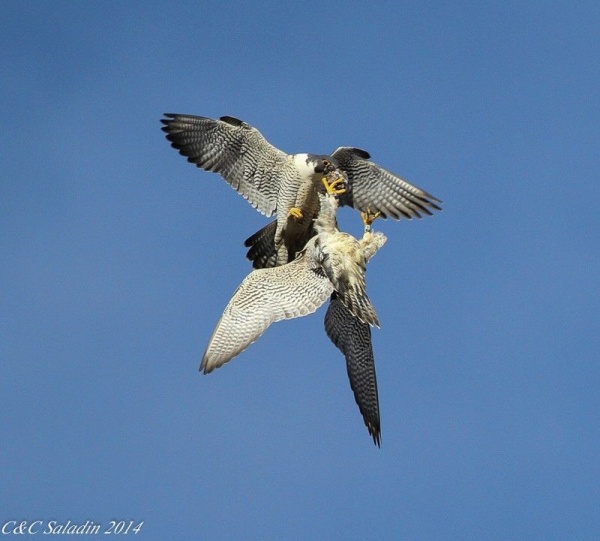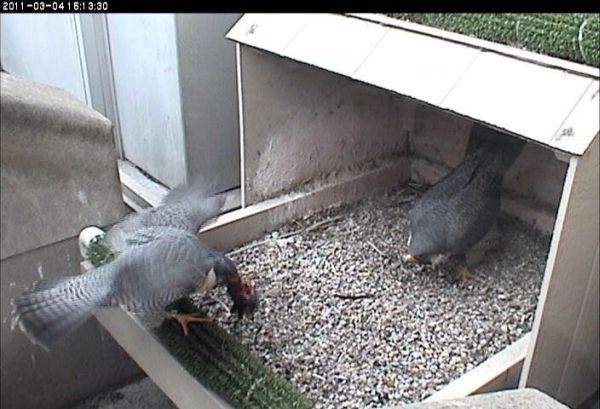
Providing food for his lady is an important part of male peregrine courtship.
At least six weeks before his mate lays eggs, the male begins to bring her food. At first he may seem reluctant to hand it over or she may snatch it by force, but as egg-laying time approaches she stops hunting on her own, he supplies all her needs, and they add ritual to the food exchange.
One ritual that many male peregrines engage in, and that E2 insists on doing, is an exaggerated plucking display. He doesn’t give the food to his mate right away, even if she flies out to meet him. He makes her wait until it’s properly prepared.
The male takes the prey to a cache area, removes the head and wings and makes an elaborate show of plucking it. The feathers fly! As you walk below the Cathedral of Learning you’ll notice feathers floating down from above. You won’t see the plucking display on camera. The male does it elsewhere on the cliff.
Sometimes he takes a few bites of the prey to sustain himself. When it’s ready, he presents it to his lady in the air or on a ledge.
Above, Mo offers prey to his mate Mystic in an aerial food exchange by holding it out with his beak. Mystic flips upside down to take it using her talons.
Alternatively, the male may present it to his mate while she’s standing on a ledge. In the photo below E2 is presenting food to Dorothy who is bowing in return.

This photo shows that E2 is breaking a (human) rule of peregrine behavior. In 2001 when I began watching nesting peregrines at Pitt I learned that “the male peregrine will not bring food to the nest until the eggs hatch. When you see him bring food to the nest you’ll be able to estimate the hatch date.”
It’s very unusual for food to be taken to the nest during courtship but E2 occasionally breaks the rule. If he feels like delivering it there, he does so, though rarely.
“For you, my dear,” he says.
p.s. If a delivery is made to the nest before the eggs hatch, the female takes the food away to eat it.
(photo from the National Aviary webcam at the University of Pittsburgh’s Cathedral of Learning)
Is it just me, or is the resolution on the Cathedral cam not as good as last year? 🙁
The resolution on the Cathedral Cam varies depending on light levels and streaming issues. Sometimes it is worse, sometimes better.
Is there a way someone could zoom out the Cathedral Cam? It seems like every time I’m on, she’s just out of view. I sort of prefer the still shot cam because it shows more.
(Of course, it IS nice to see it zoomed in once the egg-sitting has started.)
Tried to zoom it out but it doesn’t go back any further. For a zoomed-out view, click on the still image at the bottom right of the webpage and you’ll see a snapshot (zoomed out) that refreshes every 15 seconds.
Dear Kate–I am so sorry we weren’t able to join you on March 7. I agree with the others who say you MUST (please!) do it again!
I’m putting my question here because it has to do with flying and hunting. Is Dorothy “in confinement” like ladies of old because she is laying eggs? If I see a raptor couple–as I did earlier yesterday–can I assume it’s a redtail or some other? I was in the car and driving, so didn’t get the best look!
Anne
The literature on peregrines indicates that the female becomes lethargic and almost appears to be ill (though she is not) during the period while she’s laying eggs. In the days leading up to egg laying, Dorothy would probably stay close to home.
That said, it’s hard to know for sure what you saw. Dorothy *will* leave home to attack intruders and anything that threatens her eggs (such as other raptors).